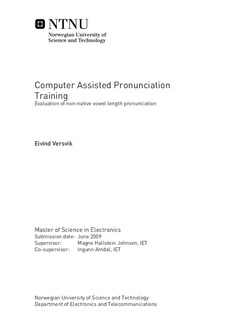Computer Assisted Pronunciation Training: Evaluation of non-native vowel length pronunciation
Master thesis
Permanent lenke
http://hdl.handle.net/11250/2369197Utgivelsesdato
2009Metadata
Vis full innførselSamlinger
Sammendrag
Computer Assisted Pronunciation Training systems have become popular tools to train on second languages. Many second language learners prefer to train on pronunciation in a stress free environment with no other listeners. There exists no such tool for training on pronunciation of the Norwegian language. Pronunciation exercises in training systems should be directed at important properties in the language which the second language learners are not familiar with. In Norwegian two acoustically similar words can be contrasted by the vowel length, these words are called vowel length words. The vowel length is not important in many other languages. This master thesis has examined how to make the part of a Computer Assisted Pronunciation Training system which can evaluate non-native vowel length pronunciations. To evaluate vowel length pronunciations a vowel length classifier was developed. The approach was to segment utterances using automatic methods (Dynamic Time Warping and Hidden Markov Models). The segmented utterances were used to extract several classification features. A linear classifier was used to discriminate between short and long vowel length pronunciations. The classifier was trained by the Fisher Linear Discriminant principle. A database of Norwegian words of minimal pairs with respect to vowel length was recorded. Recordings from native Norwegians were used for training the classifier. Recordings from non-natives (Chinese and Iranians) were used for testing, resulting in an error rate of 6.7%. Further, confidence measures were used to improve the error rate to 3.4% by discarding 8.3% of the utterances. It could be argued that more than half of the discarded utterances were correctly discarded because of errors in the pronunciation. A CAPT demo, which was developed in an former assignment, was improved to use classifiers trained with the described approach.
